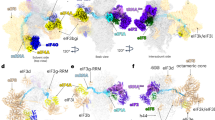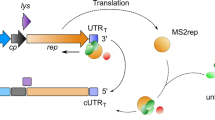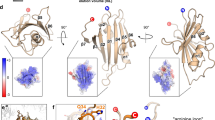Abstract
Eukaryotic translation initiation begins with assembly of a 48S ribosomal complex at the 5′ cap structure or at an internal ribosomal entry segment (IRES). In both cases, ribosomal positioning at the AUG codon requires a 5′ untranslated region upstream from the initiation site. Here, we report that translation of the genomic RNA of human immunodeficiency virus type 2 takes place by attachment of the 48S ribosomal preinitiation complex to the coding region, with no need for an upstream 5′ untranslated RNA sequence. This unusual mechanism is mediated by an RNA sequence that has features of an IRES with the unique ability to recruit ribosomes upstream from its core domain. A combination of translation assays and structural studies reveal that sequences located 50 nucleotides downstream of the AUG codon are crucial for IRES activity.
This is a preview of subscription content, access via your institution
Access options
Subscribe to this journal
Receive 12 print issues and online access
$189.00 per year
only $15.75 per issue
Buy this article
- Purchase on Springer Link
- Instant access to full article PDF
Prices may be subject to local taxes which are calculated during checkout





Similar content being viewed by others
References
Bock, P.J. & Markovitz, D.M. Infection with HIV-2. AIDS 15 (Suppl. 5), S35–S45 (2001).
Lemey, P. et al. Tracing the origin and history of the HIV-2 epidemic. Proc. Natl. Acad. Sci. USA 100, 6588–6592 (2003).
Butsch, M. & Boris-Lawrie, K. Destiny of unspliced retroviral RNA: ribosome and/or virion? J. Virol. 76, 3089–3094 (2002).
Reeves, J.D. & Doms, R.W. Human immunodeficiency virus type 2. J. Gen. Virol. 83, 1253–1265 (2002).
Gallie, D.R. Protein-protein interactions required during translation. Plant Mol. Biol. 50, 949–970 (2002).
Dever, T.E. Translation initiation: adept at adapting. Trends Biochem. Sci. 24, 398–403 (1999).
Pestova, T.V. et al. Molecular mechanisms of translation initiation in eukaryotes. Proc. Natl. Acad. Sci. USA 98, 7029–7036 (2001).
Proud, C.G. Control of the translational machinery in mammalian cells. Eur. J. Biochem. 269, 5337 (2002).
Pestova, T.V. & Kolupaeva, V.G. The roles of individual eukaryotic translation initiation factors in ribosomal scanning and initiation codon selection. Genes Dev. 16, 2906–2922 (2002).
Merrick, W.C. Cap-dependent and cap-independent translation in eukaryotic systems. Gene 332, 1–11 (2004).
Stoneley, M. & Willis, A.E. Cellular internal ribosome entry segments: structures, trans-acting factors and regulation of gene expression. Oncogene 23, 3200–3207 (2004).
Spahn, C.M. et al. Cryo-EM visualization of a viral internal ribosome entry site bound to human ribosomes: the IRES functions as an RNA-based translation factor. Cell 118, 465–475 (2004).
Kieft, J.S., Zhou, K., Jubin, R. & Doudna, J.A. Mechanism of ribosome recruitment by hepatitis C IRES RNA. RNA 7, 194–206 (2001).
Costantino, D. & Kieft, J.S. A preformed compact ribosome-binding domain in the cricket paralysis-like virus IRES RNAs. RNA 11, 332–343 (2005).
Brasey, A. et al. The leader of human immunodeficiency virus type 1 genomic RNA harbors an internal ribosome entry segment that is active during the G2/M phase of the cell cycle. J. Virol. 77, 3939–3949 (2003).
Buck, C.B. et al. The human immunodeficiency virus type 1 gag gene encodes an internal ribosome entry site. J. Virol. 75, 181–191 (2001).
Lorsch, J.R. & Herschlag, D. Kinetic dissection of fundamental processes of eukaryotic translation initiation in vitro. EMBO J. 18, 6705–6717 (1999).
Draper, D.E. A guide to ions and RNA structure. RNA 10, 335–343 (2004).
Zuker, M. Mfold web server for nucleic acid folding and hybridization prediction. Nucleic Acids Res. 31, 3406–3415 (2003).
Michel, F. Some questions concerning RNA folding. in Folding and Self-Assembly of Biological Macromolecules (eds. Westhof, E. & Hardy, N.) 127–178 (World Scientific Publishing, 2004).
Damgaard, C.K., Andersen, E.S., Knudsen, B., Gorodkin, J. & Kjems, J. RNA interactions in the 5′ region of the HIV-1 genome. J. Mol. Biol. 336, 369–379 (2004).
Abbink, T.E. & Berkhout, B. A novel long distance base-pairing interaction in human immunodeficiency virus type 1 RNA occludes the Gag start codon. J. Biol. Chem. 278, 11601–11611 (2003).
Paillart, J.C., Skripkin, E., Ehresmann, B., Ehresmann, C. & Marquet, R. In vitro evidence for a long range pseudoknot in the 5′-untranslated and matrix coding regions of HIV-1 genomic RNA. J. Biol. Chem. 277, 5995–6004 (2002).
Paillart, J.C. et al. First snapshots of the HIV-1 RNA structure in infected cells and in virions. J. Biol. Chem. 279, 48397–48403 (2004).
Ohlmann, T., Pain, V.M., Wood, W., Rau, M. & Morley, S.J. The proteolytic cleavage of eukaryotic initiation factor (eIF) 4G is prevented by eIF4E binding protein (PHAS-I; 4E–BP1) in the reticulocyte lysate. EMBO J. 16, 844–855 (1997).
Ohlmann, T., Rau, M., Morley, S.J. & Pain, V.M. Proteolytic cleavage of initiation factor eIF-4 gamma in the reticulocyte lysate inhibits translation of capped mRNAs but enhances that of uncapped mRNAs. Nucleic Acids Res. 23, 334–340 (1995).
Ohlmann, T., Rau, M., Pain, V.M. & Morley, S.J. The C-terminal domain of eukaryotic protein synthesis initiation factor (eIF) 4G is sufficient to support cap-independent translation in the absence of eIF4E. EMBO J. 15, 1371–1382 (1996).
Borman, A.M. et al. elF4G and its proteolytic cleavage products: effect on initiation of protein synthesis from capped, uncapped, and IRES-containing mRNAs. RNA 3, 186–196 (1997).
Ziegler, E., Borman, A.M., Kirchweger, R., Skern, T. & Kean, K.M. Foot-and-mouth disease virus Lb proteinase can stimulate rhinovirus and enterovirus IRES-driven translation and cleave several proteins of cellular and viral origin. J. Virol. 69, 3465–3474 (1995).
Berkhout, B. Structure and function of the human immunodeficiency virus leader RNA. Prog. Nucleic Acid Res. Mol. Biol. 54, 1–34 (1996).
Griffin, S.D., Allen, J.F. & Lever, A.M. The major human immunodeficiency virus type 2 (HIV-2) packaging signal is present on all HIV-2 RNA species: cotranslational RNA encapsidation and limitation of Gag protein confer specificity. J. Virol. 75, 12058–12069 (2001).
Kaye, J.F. & Lever, A.M. Nonreciprocal packaging of human immunodeficiency virus type 1 and type 2 RNA: a possible role for the p2 domain of Gag in RNA encapsidation. J. Virol. 72, 5877–5885 (1998).
Wehrly, K. & Chesebro, B. p24 antigen capture assay for quantification of human immunodeficiency virus using readily available inexpensive reagents. Methods 12, 288–293 (1997).
Kent, K.A. et al. Production and of monoclonal antibodies to simian immunodeficiency virus envelope glycoproteins. AIDS 5, 829–836 (1991).
Berlioz, C. & Darlix, J.L. An internal ribosomal entry mechanism promotes translation of murine leukemia virus gag polyprotein precursors. J. Virol. 69, 2214–2222 (1995).
Gallie, D.R., Ling, J., Niepel, M., Morley, S.J. & Pain, V.M. The role of 5′-leader length, secondary structure and PABP concentration on cap and poly(A) tail function during translation in Xenopus oocytes. Nucleic Acids Res. 28, 2943–2953 (2000).
Ohlmann, T., Lopez-Lastra, M. & Darlix, J.L. An internal ribosome entry segment promotes translation of the simian immunodeficiency virus genomic RNA. J. Biol. Chem. 275, 11899–11906 (2000).
Prevot, D. et al. Characterization of a novel RNA-binding region of eIF4GI critical for ribosomal scanning. EMBO J. 22, 1909–1921 (2003).
Chen, C.A. & Okayama, H. Calcium phosphate-mediated gene transfer: a highly efficient transfection system for stably transforming cells with plasmid DNA. Biotechniques 6, 632–638 (1988).
Ramesh, N. & Osborne, W.R. Assay of neomycin phosphotransferase activity in cell extracts. Anal. Biochem. 193, 316–318 (1991).
Butcher, S.E. & Burke, J.M. Structure-mapping of the hairpin ribozyme. Magnesium-dependent folding and evidence for tertiary interactions within the ribozyme-substrate complex. J. Mol. Biol. 244, 52–63 (1994).
Weill, L., Louis, D. & Sargueil, B. Selection and evolution of NTP-specific aptamers. Nucleic Acids Res. 32, 5045–5058 (2004).
Acknowledgements
The following reagents were obtained through the AIDS Research and Reference Reagent Program, National Institute of Allergy and Infectious Disease, US National Institutes of Health (Bethesda, Maryland, USA): monoclonal antibodies (183-H12-5C) from B. Chesebro and K. Wehrly, and SIV Gag monoclonal antibody (KK59) from K. Kent and C. Powell. We would like to thank F. Michel for helpful discussion about three-dimensional RNA structures and P.F. Ray for critical reading of the manuscript. C.H.H. and L.W. are funded by MENRT, SIDACTION and FRM grants and work in our laboratory is supported by grants from the ANRS, CNRS, INSERM, an ACI and TRIOH from EC sixth PCRD.
Author information
Authors and Affiliations
Corresponding authors
Ethics declarations
Competing interests
The authors declare no competing financial interests.
Supplementary information
Supplementary Fig. 1
Expression of Gag p57, p50 and p44 in RRL pretreated with the FMDV L protease. (PDF 144 kb)
Supplementary Fig. 2
Stability and integrity of the bicistronic RNA constructs in the RRL. (PDF 122 kb)
Supplementary Figure 3
Stability and integrity of the leaderless RNA constructs in the RRL. (PDF 132 kb)
Supplementary Fig. 4
Example of chemical probing experiment. (PDF 171 kb)
Supplementary Fig. 5
Removal of the first 50 nucleotides of the coding region drastically impairs initiation at the first AUG of gag. (PDF 20 kb)
Rights and permissions
About this article
Cite this article
Herbreteau, C., Weill, L., Décimo, D. et al. HIV-2 genomic RNA contains a novel type of IRES located downstream of its initiation codon. Nat Struct Mol Biol 12, 1001–1007 (2005). https://doi.org/10.1038/nsmb1011
Received:
Accepted:
Published:
Issue Date:
DOI: https://doi.org/10.1038/nsmb1011
This article is cited by
-
Identification of cryptic putative IRESs within the ORF encoding the nonstructural proteins of the human rhinovirus 16 genome
Archives of Virology (2021)
-
A researcher’s guide to the galaxy of IRESs
Cellular and Molecular Life Sciences (2017)
-
HIV-1 sequences isolated from patients promote expression of shorter isoforms of the Gag polyprotein
Archives of Virology (2016)
-
The translation initiation factor DAP5 promotes IRES-driven translation of p53 mRNA
Oncogene (2014)
-
Mechanism of HIV-1 Tat RNA translation and its activation by the Tat protein
Retrovirology (2009)



